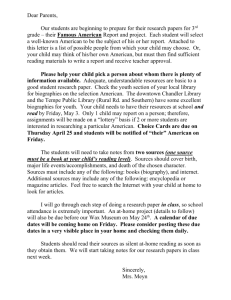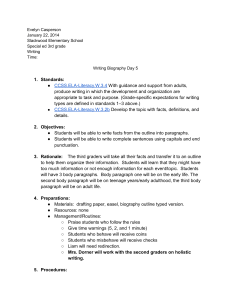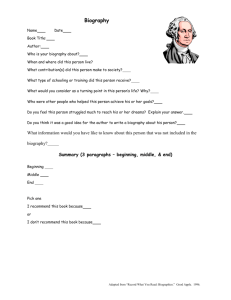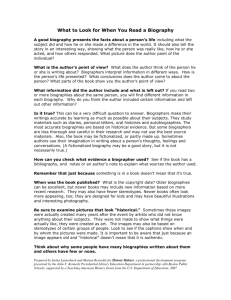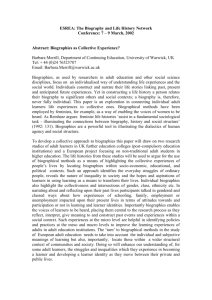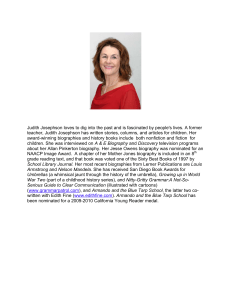MD7LessonPlanFordR
advertisement
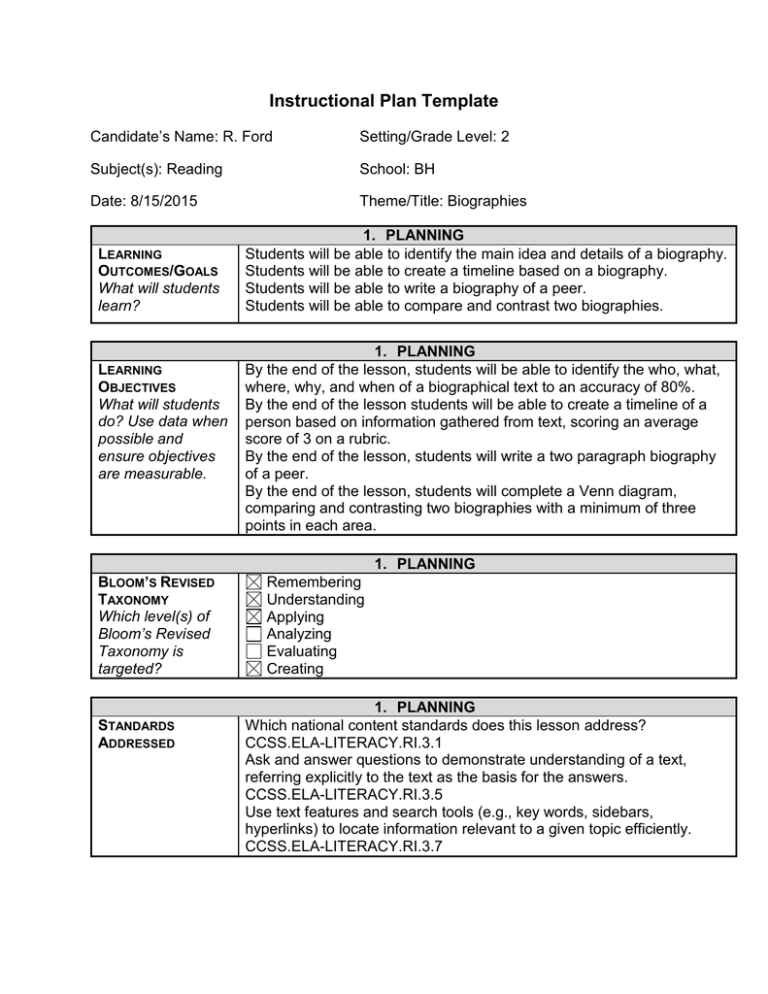
Instructional Plan Template Candidate’s Name: R. Ford Setting/Grade Level: 2 Subject(s): Reading School: BH Date: 8/15/2015 Theme/Title: Biographies LEARNING OUTCOMES/GOALS What will students learn? LEARNING OBJECTIVES What will students do? Use data when possible and ensure objectives are measurable. 1. PLANNING Students will be able to identify the main idea and details of a biography. Students will be able to create a timeline based on a biography. Students will be able to write a biography of a peer. Students will be able to compare and contrast two biographies. 1. PLANNING By the end of the lesson, students will be able to identify the who, what, where, why, and when of a biographical text to an accuracy of 80%. By the end of the lesson students will be able to create a timeline of a person based on information gathered from text, scoring an average score of 3 on a rubric. By the end of the lesson, students will write a two paragraph biography of a peer. By the end of the lesson, students will complete a Venn diagram, comparing and contrasting two biographies with a minimum of three points in each area. 1. PLANNING BLOOM’S REVISED TAXONOMY Which level(s) of Bloom’s Revised Taxonomy is targeted? STANDARDS ADDRESSED Remembering Understanding Applying Analyzing Evaluating Creating 1. PLANNING Which national content standards does this lesson address? CCSS.ELA-LITERACY.RI.3.1 Ask and answer questions to demonstrate understanding of a text, referring explicitly to the text as the basis for the answers. CCSS.ELA-LITERACY.RI.3.5 Use text features and search tools (e.g., key words, sidebars, hyperlinks) to locate information relevant to a given topic efficiently. CCSS.ELA-LITERACY.RI.3.7 Use information gained from illustrations (e.g., maps, photographs) and the words in a text to demonstrate understanding of the text (e.g., where, when, why, and how key events occur). CCSS.ELA-LITERACY.RF.3.3.B Decode words with common Latin suffixes. CCSS.ELA-LITERACY.RF.3.3.C Decode multisyllable words. CCSS.ELA-LITERACY.W.3.3 Write narratives to develop real or imagined experiences or events using effective technique, descriptive details, and clear event sequences. Which state content standards does this lesson address? Iowa Core RI.3.1 Ask and answer questions to demonstrate understanding of a text, referring explicitly to the text as the basis for the answers RI.3.5 Use text features and search tools (e.g., key words, sidebars, hyperlinks) to locate information relevant to a given topic efficiently RI.3.7 Use information gained from illustrations (e.g., maps, photographs) and the words in a text to demonstrate understanding of the text (e.g., where, when, why, and how key events occur). RF. 3.3 Know and apply grade–level phonics and word analysis skills in decoding words b. Decode words with common Latin suffixes. c. Decode multisyllable words. W.3.3 Write narratives to develop real or imagined experiences or events using effective technique, descriptive details, and clear event sequences. SS.3–5.H.4 Essential Concept and/or Skill: Understand the role of individuals and groups within a society as promoters of change or the status quo. Other REAL WORLD CONTEXTS What real-world contexts are included in the lesson? If not included, please explain why real- 1. PLANNING The literacy skills will be used throughout academic careers. The students will be able to transfer knowledge of timelines to other grades and content areas. Through learning about influential individuals from various cultures and backgrounds, students will understand the impact an individual can have on society. They will also understand that their individual story can change regardless of their current status. Through the reading about these individuals, students will develop respect and appreciation of the individuals and their cultures. 1. PLANNING world contexts are not appropriate for this lesson. COLLABORATION Was collaboration with other professionals, families, or community leaders included for this lesson? Describe the collaborative effort. If collaboration was not included, please give a rationale of why it was not needed. LEARNING EXPERIENCE/ ACTIVITY List the activities, including how you activate background knowledge and bring closure to the lesson. Please make sure you can demonstrate student engagement throughout the lesson. 1. PLANNING Because I am not a third grade teacher, I collaborated with our literacy coach and a third grade teacher. I needed to understand the literacy expectations for third graders. I also collaborated with colleagues, including our librarian about individuals who would be appropriate to study from various cultures. 2. METHODOLOGY Introductory/Anticipatory Set We will begin the lesson by watching a brainpop.com video on Abraham Lincoln. This will introduce the topic of biographies and historical individuals. Building/Applying Knowledge and Skills by engaging students in their learning I will model the expectations and process of reading biographies and creating timelines with the book Martin Luther King Jr. by Bea Silverberg. Students will then be given a choice of which two biographies they will read in the same manner. Upon completion of the reading, students will create a timeline based on one of the individuals about which they read. Students will then compare and contrast the two biographies. 2. METHODOLOGY Extension/Enrichment/Transfer or Generalization of Knowledge that engages students in their learning Students will be placed in pairs where they will create a timeline of their own lives. Upon completion of the timelines, students will write a two paragraph biography of their partner, using sequential words. Synthesis/Closure Students will share the biography of their classmate. 2. METHODOLOGY INSTRUCTIONAL STRATEGIES What instructional strategies/methods will you use? Constructions Nonlinguistic Representations Cooperative Learning Peer Editing Discovery Practice/Drill Discussion/Questioning Practicum Experiment Problem Solving Questions, Cues, and Advance Organizers Reflection/Response Reinforcing Effort and Providing Recognition Reporting Field Study Graphic Organizers Generating and Testing Hypothesis Homework and Practice Identifying Similarities and Differences Role-playing Journal Setting Objectives and Providing Feedback Simulation Laboratory Summarizing and Note Taking Lecture Viewing/Listening/Answering Library Research Other (Please specify): Independent Learning Why did you choose these instructional strategies/methods? These strategies will engage students and provide opportunities for scaffolding of instruction and learning. Students will make connections and use real world situations to create their biography. 2. METHODOLOGY How will you group students for instruction (individual, small group, large group, or whole class)? Students will be placed in pairs. Small group instruction will be provided as needed, and individual supports will be provided through conferencing and direct instruction. 3. MATERIALS MATERIALS USED T = FOR TEACHER S = FOR STUDENT T S Materials used Video Reading A-Z books Martin Luther King Jr. by Bea Silverberg, Amelia Earhart: A Legend in Flight by Julie Mettenberg, Barack Obama by R.K. Burrice, Bessie Coleman by Jane Sellman, Cesar Chavez: Migrant Hero by Terry L. Scott, Helen Keller by Ellen Forrest, and Sonia Joins the Supreme Court by Cynthia Kennedy Henzel. Highlighters Venn diagram Sample timeline T S Technology utilized Cassettes/CDs Graphing or Scientific Calculator Slides Tape Recorder VCR/TV/DVD/Laser disc Assistive Technology Cell Phone/Mobile Device Digital/Video Camera Concept Mapping Software Social Networking Virtual World (e.g., Second Life) Interactive Gaming Interactive White Board (e.g., SMART Board) Distance Learning/Webcast Computer Software 3. MATERIALS Weblog (Blog) Wiki Internet Research/Website Podcast/Vodcast E-mail Presentation Software (e.g., PowerPoint) Virtual Field Trip Interactive Gaming Other (Please specify): 4. ASSESSMENT/EVALUATION ASSESSMENT OPTIONS Application Exam Concept Mapping Parent Evaluation Peer Evaluation Self-Evaluation Inventory Quantitative Scale Rubric Journal Objective Test Observation Contract Checklist Performance Portfolio Rating Scales Scored Discussion Problem-Solving Assessment Other (Please specify): Why did you choose this assessment(s)? How will the chosen assessment(s) help you determine if your students met the goals/objectives? In your answer, provide a rationale for each assessment you plan to use and its connection with each of your goals/objectives. Using formative assessments such as observations provide information needed to ensure that all students are understanding the task, and inform my instruction. The use of rubrics allows the students to see the expectations so that they can work to meet them. How will you use this assessment data to inform your instruction? These assessments will inform my instruction by identifying students who are struggling with specific aspects of the lesson so that I can make modifications as necessary. DIFFERENTIATION 5. LEARNERS How will you differentiate curriculum to meet diverse student needs? The curriculum content can be altered based on learning needs, such as text complexity. How will you differentiate instruction to meet diverse student needs? 5. LEARNERS Instruction can be presented in small group and individual settings. If needed more modeling and examples will be used. How will you differentiate assessment to meet diverse student needs? Students can present information in various formats if needed. Students can use illustrations, or dictate information. DIVERSITY MULTIPLE INTELLIGENCES AND LEARNING STYLES MULTIPLE INTELLIGENCES AND LEARNING STYLES 5. LEARNERS How will you address the needs of diverse students (e.g., IEP, 504, readiness level, cultural/linguistic background)? Texts can be read aloud, and are available in another language. Students can present information in various ways. ELL students can write in their native language and translate information verbally. The chosen texts vary in reading level and are presented with cultural diversity in mind. I have selected individuals from various cultural backgrounds. 5. LEARNERS What multiple intelligences will you address? Visual/Spatial Verbal/Linguistic Logical/Mathematical Bodily/Kinesthetic Musical/Rhythmic Interpersonal Intrapersonal Naturalist Existential 5. LEARNERS What learning styles will you address? Sensing-Thinking Sensing-Feeling Intuition-Feeling Intuition-Thinking


